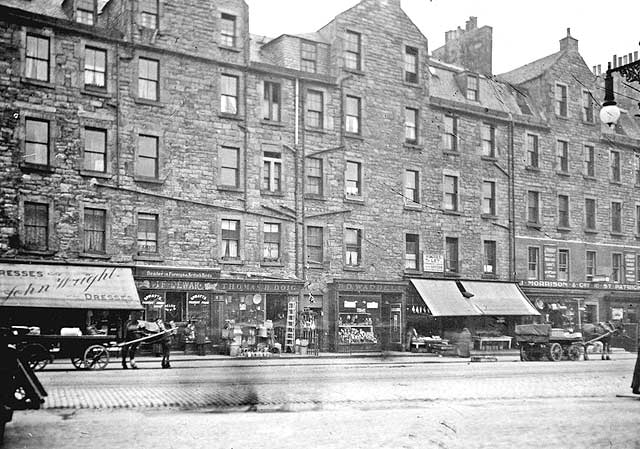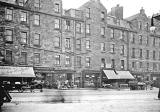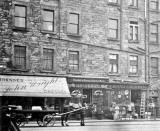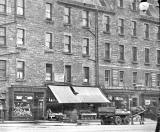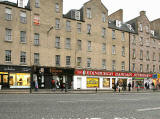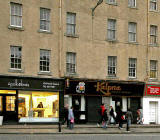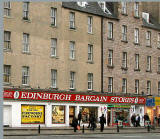|
The east side of St Patrick's Square When? ANSWER WHEN?: Photo taken between 1907 and 1918 (See Answer 4 below) |
© Reproduced with acknowledgement to John Stirling, Currie, Edinburgh: Oct 22, 2009 Photographer not known
|
Answer 1. John Stirling Currie, Edinburgh |
|
Old Photo Thank you to John Stirling for allowing me to reproduce this photo. It is one of a of a collection made from glass plates that John rescued from being destroyed in 1974. The photographer is not known. John wrote: "The location of this photo could be Nicolson Street." John Stirling, Currie, Edinburgh: Oct 23, 2009 |
|
Answer 2. Peter Stubbs Edinburgh |
|
St Patrick Square John Stirling was just about correct in identifying this location. In fact this photograph is of the east side of St Patrick Square. That's the short stretch of road between Nicolson Street and Clerk Street, immediately to the south of Nicolson Street he Edinburgh & Leith Post Office Directory for 1930-31 gives the following addresses: - 1 St Patrick Square: John Wright, Draper. - 2 St Patrick Square: James F Dewar. - 3 St Patrick Square: Thomas B Doig. Also, the shop on the right hand side of this photo appears to be at: - 10 St Patrick Square. The 1930-31 directory is the earliest directory that I have, but the photo was probably taken some time earlier, so by consulting directories for earlier years it may be possible to identify more of the shops, and to estimate the date of this photo. |
|
Zoom-in Please click on the thumbnail images below to zoom-in to the sops on the left and right of the photograph at the top of this page. |
|
Peter Stubbs, Edinburgh: October 24, 2009 |
|
Answer 3. Bryan Gourlay Biggar, Lanarkshire, Scotland |
|
Thank you to Bryan Gourlay, Biggar, Lanarkshire, Scotland who wrote: 1950s and 1960s "I remember the east side of St Patrick Square well from the 1950s and 1960s. At that time, there was a sizeable furniture shop on that stretch, covering around three of the shops in the photo. The wide split-level pavement was still there, and just out of shot to the left was a dry cleaning shop which opened offering some sort of new-fangled American dry cleaning process. The photo is taken from the North entrance to the West side of the square. Itís not clear whether there are any tram lines or not. If not, it suggests the photo predates horse-drawn and cable cars. It looks a lot older than electric trams which didnít start until the early 1920s. I seem to remember these buildings being refurbished in the late 1960s." Bryan Gourlay, Biggar, Lanarkshire, Scotland: October 26, 2009 |
|
Answer 4. Peter Stubbs Edinburgh |
|
I've now had chance to do some further research into the date of this photo, by referring to old editions of the Edinburgh & Leith Post Office Directory. 1907 to 1918 These directories show the following shops to have been at St Patrick Square throughout the period 1905 to 1930. They may well have been at these addresses for considerably longer. - 1 St Patrick Square: John Wright, Draper. - 2 St Patrick Square: James F Dewar. - 3 St Patrick Square: Thomas B Doig. However it is this shop, at the right-hand side of the photo, that helps to narrow down the date of this photo. - 10 St Patrick Square: J Morrison It was only listed in the directories as being at this address for the years 1907 to 1918, so the photograph must have been taken some time during this period. |
|
Peter Stubbs, Edinburgh: October 24, 2009 |
|
Answer 5. Peter Stubbs Edinburgh |
||
|
Changes over the last Century Here we can compare the photo taken in the early-1900s (1907 to 1918) with a photo that I took of the same section of street today. The transport and shops have changed, but the buildings are still very recognisable. Please click on any of the thumbnail images below to enlarge them. |
||
|
Early 1900s |
||
|
zoom-in (left) |
zoom-in (right) |
|
|
2009 |
||
|
zoom-in (left) |
zoom-in (right) |
|
|
Peter Stubbs, Edinburgh: October 26, 2009 |
||
|
Answer 6. Bob Henderson Burdiehouse, Edinburgh |
|
Thank you to Bob Henderson who wrote: Flat Conversions "I have just been looking at the St Patrick square pictures. They show quite clearly some of the internal changes that have been made to the building. Nearly all of the waste pipes from kitchen sinks, seen on the old photo, have now disappeared. Only the rainwater pipes from the rhones remain. If you look at the number of sink wastes on the old photo, it will give you an idea of how many apartments were front-facing. This would have been mirrored to the rear of the building. The largest of these would be 2-apartment flats and some of them would be single-ends with a box bedroom. In the 1950s and 1960s, the flats in this building would have been reconfigured to give at least one bedroom and in some cases two. At least, that's my experience, having worked as a joiner on many conversions like this in the town." Bob Henderson, Burdiehouse, Edinburgh: October 27 + 28. 2009 |
|
Answer 7. John Stirling Currie, Edinburgh |
|
Thank you to John Stirling, who has been studying the history of sanitary conditions in some of Edinburgh's housing, for commenting on this topic. John wrote: Living Conditions "Bob Henderson's notes relating to sink wastes (6 above) are correct. However, when this photo was taken, it would have been much worse. Some of the sinks may have been common to more than one house." John Stirling, Currie, Edinburgh: October 29, 2009 |
